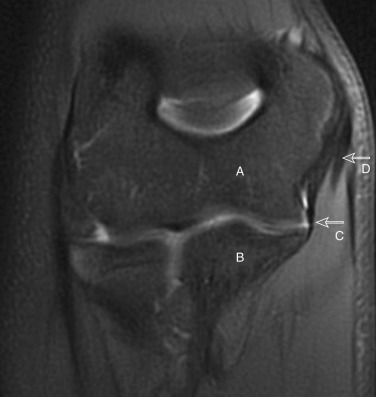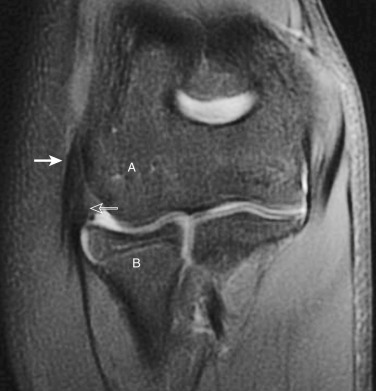Physical Address
304 North Cardinal St.
Dorchester Center, MA 02124
Name the labeled structures of the elbow shown on magnetic resonance imaging (MRI) in Figures 53-1 and 53-2 .


What are the three articulations of the elbow?
The radiocapitellar, ulnotrochlear, and proximal radioulnar joints. The three articulations are within a common joint capsule and work together as a hinge, allowing flexion/extension at the elbow and supination/pronation of the forearm.
The common flexor tendon refers to the common origin for the flexor muscles of the forearm including the pronator teres, flexor carpi radialis, palmaris longus, flexor digitorum superficialis, and flexor carpi ulnaris muscles. It originates at the medial epicondyle, which is the bony protuberance at the medial aspect of the distal humerus proximal to the trochlea.
The common extensor tendon refers to the common origin of the extensor muscles of the forearm including the extensor carpi radialis longus, extensor carpi radialis brevis, extensor digitorum communis, extensor carpi ulnaris, and extensor digiti minimi muscles. It originates from the lateral epicondyle, which is the bony projection of the lateral aspect of the distal humerus proximal to the capitellum. The anconeus and supinator muscles also originate at the lateral epicondyle.
The UCL, also known as the medial collateral ligament (MCL), is a focal thickening of the medial joint capsule. It stabilizes the medial aspect of the elbow and resists valgus stress. The UCL is comprised of three components: the anterior bundle, posterior bundle, and oblique band (also known as the transverse ligament).
The anterior bundle of the UCL, which arises from the inferior aspect of the medal epicondyle and extends to the medial aspect of the coronoid process (known as the sublime tubercle), is the primary restraint to valgus stress at the elbow.
Radial collateral ligament, lateral ulnar collateral ligament (LUCL), and annular ligament. The annular ligament is attached to the ulna and wraps around the radial head, acting as the primary stabilizer of the radioulnar joint and preventing dislocation of the radial head. The radial collateral ligament extends in a fan shape from the lateral epicondyle to the annular ligament. The LUCL arises from the posterior aspect of the lateral epicondyle and extends around the posterior aspect of the radial head and neck to the ulna.
The LUCL acts as a sling that extends around the posterior radial head and neck and is the primary stabilizer to varus stress. Disruption of the LUCL leads to posterolateral rotatory instability. The LUCL is frequently disrupted following posterior elbow dislocations.
Become a Clinical Tree membership for Full access and enjoy Unlimited articles
If you are a member. Log in here